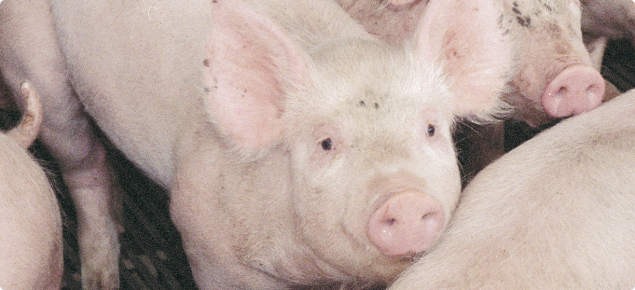On-farm handling for quality pork
Pigs that are stressed prior to slaughter have a faster rate of acid formation in the muscle (muscle glycogen broken down to lactic acid) post-slaughter and the muscle reaches a low pH while the carcass temperature is still high. This results in pale, soft, exudative (PSE) pork. Apart from the inferior appearance and excessive drip loss, PSE pork is tough and dry when cooked. In addition to increasing the level of PSE, negative handling of pigs also results in increased carcass damage due to bruising.
The handling of pigs on-farm, during transportation and at the abattoir is not only dependent on the relationship between the animal and the stockperson but also on the surrounding environment. Some environmental factors that can have a major impact on the way the pigs react when handled include:
- the design of pens and laneways between pens
- shed and laneway lighting
- noise
- number of pigs per pen
- raceway to the loading ramp
- the loading ramp design.
Improper design of on-farm facilities can hamper the movement of pigs resulting in a greater risk of pigs becoming stressed due to increased stockperson intervention. Negative handling (slapping, shouting etc) on such pigs will only increase the problem and further stress the pigs.
Practices and procedures for better handling of pigs on-farm
Some practices and procedures that can be adopted to assist in the better handling of pigs on-farm include:
- Avoid mixing different groups of pigs to reduce fighting.
- Move pigs in small groups of 10-15.
- Avoid moving pigs in areas that have strong light contrasts (dark to light).
- Laneways and races should be unrestricted as objects such as brooms, pen scrapers etc can cause pigs to baulk.
- Floor surfaces, floor levels and wall types should be as consistent as possible because pigs tend to baulk when confronted by drain grates, steps, puddles, hoses etc.
- Maintenance of building and pens are regularly required in piggeries, however this should be done in a manner where pigs are shielded from such work.
- Select and tattoo pigs for slaughter at least one day before transport.
- Draft pigs into transport/slaughter pen groups prior to arrival of the transport vehicle.
- Avoid loading and transporting pigs in extreme temperatures (many producers have reported that pigs load much easier just after first light).
- Loading ramps should be wide enough for two bacon size pigs to prevent jamming of pigs.
- Loading ramp slopes should not exceed 20 degrees and should have cross cleats (200 millimetres apart) to minimise pigs slipping.
Stockpersons are an integral part of intensive pig production, hence due attention and care needs to be directed towards the pig/stockperson relationship. However, it should not be forgotten that proper handling of pigs is not just about the animal and the handler but also their environment. By paying attention to the pig and its environment, significant gains can be made in welfare, productivity and pork quality.
Paying attention to the needs of pigs also provides a better working environment for the stockperson, a fact often forgotten or neglected.

